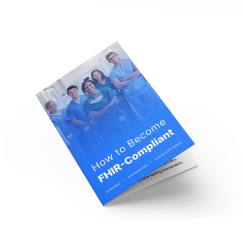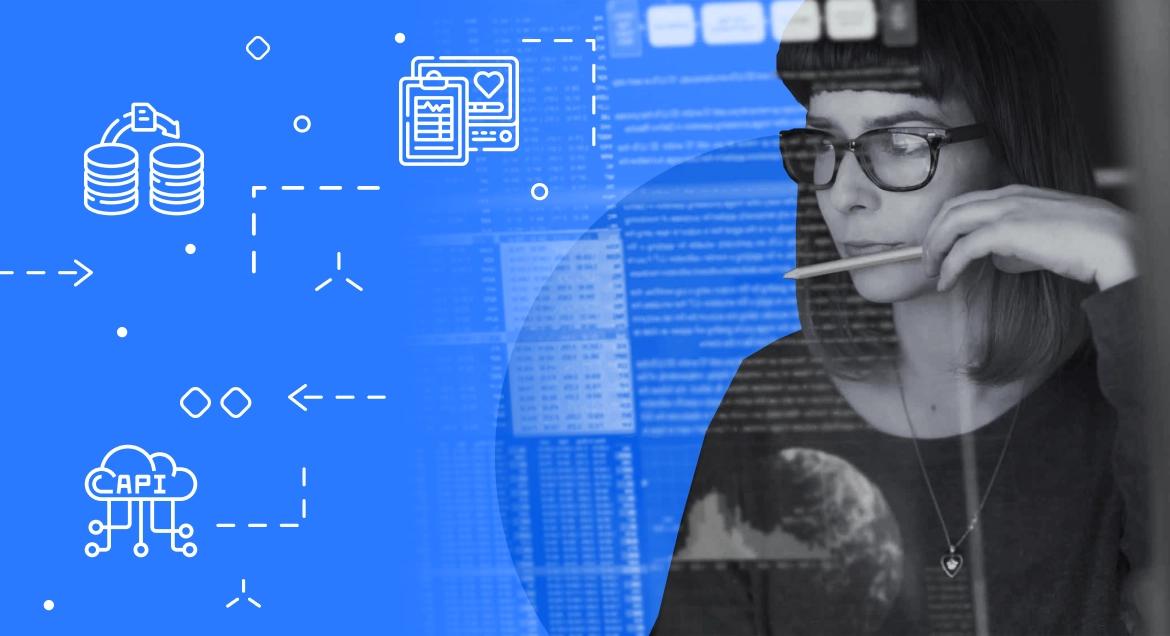The healthcare industry is responsible for 30% of the global data volume, which will continue to grow. By 2025, the compound annual growth rate is expected to reach 36%, outpacing the manufacturing, media, entertainment, and finance industries (Source ). With the increasing complexity and scale of healthcare data, healthcare data migration is becoming critical for organizations looking to stay competitive.
Migrating healthcare data is the key to enabling providers to expand their operations, implement advanced IT analytics, and adopt more efficient systems. This process allows organizations to optimize patient care, ensure compliance, and transition to more secure and scalable infrastructures.
By the end of this article, you'll know:
- The key strategies for healthcare data migration;
- The stages involved in the migration process;
- Tools and best practices for successful migration;
- How Binariks can assist with healthcare data migration.
Keep reading to discover how you can successfully handle large-scale healthcare data migrations.
What is data migration in healthcare?
Healthcare data migration involves transferring patient information and service-related data from one storage system to another. This process frequently overlaps with EHR data migration since most healthcare providers manage patient records through Electronic Health Record software.
Electronic Health Records are systems that centralize all patient-related data, including medical history, treatments, insurance details, billing, and other critical information. While EHR systems are essential for streamlining healthcare operations, they can become outdated. Healthcare organizations may need to scale their systems, enhance data security, meet evolving regulatory requirements, or integrate advanced analytics solutions. These needs often require migrating data from legacy systems to modern platforms.
There are different types of migrations in healthcare, each with specific goals and challenges:
- EHR data migration: Moving patient records and related information from one EHR system to another due to updates, system upgrades, or vendor changes.
- Clinical data migration: Transferring clinical information, such as lab results, imaging, and treatment plans, to ensure continuity in care delivery.
- Medical data migrations: The process of moving vast medical records and documentation to more advanced systems to improve efficiency, security, and accessibility.
Healthcare data migration is essential for modernizing systems and ensuring secure, accessible patient data. Next, we'll look at key strategies for successful data migration.
Healthcare data migration approaches: Choosing the right path
When planning a healthcare IT migration, selecting the right strategy is essential to ensure a smooth transition and minimize disruptions. Below are the main types of data migration strategies commonly used in the healthcare industry:
| Migration Strategy | Description | When to Use |
| Full Data Migration | Involves migrating all data from the source system to the target system in one go. This is often done during planned downtime to avoid disruptions. | It is best for smaller organizations or situations where all patient data migration must be completed simultaneously, such as legacy system replacement. |
| Trickle Data Migration | Data is migrated in stages, allowing both the source and target systems to run simultaneously. This minimizes downtime and ensures continuous operation. | Suits larger organizations that cannot afford long downtimes and need a gradual, low-risk transition. |
| Big Bang Migration | All data is transferred within a limited time window, usually during a system shutdown. Requires thorough planning and testing to avoid failures. | Suitable when organizations can schedule a clear-cut migration during downtime, often used in smaller setups. |
| Phased Migration | Involves migrating data in phases, typically by departments, locations, or services. Each phase is fully tested before proceeding to the next. | Effective for larger organizations or complex systems where a step-by-step approach reduces the risk of failure. |
| Cloud-Based Migration | Moves data from on-premise systems to cloud-based storage or systems, offering better scalability and security options. | It is best for organizations looking to modernize infrastructure and improve data accessibility and security. |
| Hybrid Migration | Combines on-premise and cloud migration, allowing organizations to keep sensitive data in-house while moving other data to the cloud. | Ideal for organizations with sensitive data that require a balance between on-premise and cloud solutions. |
Choosing the right strategy depends on the specific needs of the healthcare organization, available resources, and the complexity of the healthcare IT migration project.
5 stages of the healthcare data migration process
Healthcare data migration involves extracting, transforming, and transferring data from a legacy system to a new platform. Whether it's health information system migration or moving smaller components, the process is complex and requires a multi-stage approach to ensure a smooth and accurate transition.
Below are the five essential stages of healthcare data migration and tips for overcoming potential challenges.
1. Assessment
The assessment phase is all about analyzing your current data systems and developing a strategy for migration.
- Stages:
- Review all existing systems, both electronic and paper-based, to get a complete understanding of your data landscape.
- Identify which patient records, documents, and data need to be migrated.
- Choose the tools and technology that will best support the migration process.
- Difficulties: Without a clear understanding of your data, it can be challenging to decide what to migrate and which tools to use. Partnering with a technology expert can simplify the process by helping to develop a clear migration strategy and manage the transition using healthcare data migration best practices.
Want to become HIPAA-compliant?
Learn about best practices of FHIR implementation.

2. Data cleanup
Data cleanup is the process of removing incorrect, outdated, or unnecessary information from the dataset to ensure only accurate and relevant data is migrated.
- Stages:
- Identify records that contain errors, duplicates, or incomplete information.
- Filter out irrelevant or outdated data that no longer serves the organization.
- Standardize the remaining data to ensure consistency across the system.
- Difficulties: Managing data cleanup can be time-consuming, especially when dealing with large datasets. Using automated error detection and correction tools can streamline this phase, ensuring only clean, usable data makes it to the new system.
3. Structuring
After cleaning the data, the structuring phase involves organizing and classifying records for easier management post-migration.
- Stages:
- Categorize records into meaningful groups based on medical history, patient type, or service provided.
- Create a structure that reflects how the data will be used in the new system.
- Implement data governance practices to ensure consistency across records.
- Difficulties: Unstructured data can pose significant challenges in post-migration management. However, a robust data governance framework and the use of categorization tools can effectively address this, ensuring your data remains well-organized.
4. Conversion
The conversion phase involves transforming legacy data into the required format for the new system.
- Stages:
- Analyze the format requirements of the new healthcare platform.
- Convert legacy records into compatible formats without losing information.
- Verify that all data has been successfully converted.
- Difficulties: Data loss is a major concern during this stage. Rigorous testing and validation processes must be applied to ensure no records are left behind or corrupted during conversion.
5. Migration
The final step is the actual migration of data from the legacy system to the new destination.
- Stages:
- Transfer records to the new storage system in small, manageable batches.
- Monitor the migration process to ensure all data is imported without error.
- Perform a thorough post-migration check to confirm the integrity of the data.
- Difficulties: The speed and success of the migration depend on factors like data volume, system compatibility, and the tools used. Migrating in smaller increments and continually testing the process can reduce the risk of errors and ensure a smoother transition.
Each step requires careful planning and execution to ensure data integrity and minimize disruptions. Whether you're handling large system migrations or healthcare app migrations, following these steps can help ensure a smooth transition.
Key drivers behind clinical data migration
Regulatory compliance
Healthcare organizations must comply with evolving regulations like HIPAA and GDPR, which necessitate data migrations to ensure adherence to data privacy and security standards.
- Legal compliance: Ensuring compliance with regulations, such as HIPAA, is critical to avoiding fines and maintaining patient trust.
- Audits and legal risks: Outdated systems may expose organizations to audits and legal repercussions if they fail to meet data protection standards.
Legacy system modernization
Legacy systems, while functional, are often inefficient and unable to keep up with modern healthcare demands. Migration to newer systems addresses these limitations.
- Outdated technology: Older systems lack flexibility, integration capabilities, and vendor support, leading to inefficiencies.
- High operational costs: Maintaining legacy systems is expensive, and migrating to modern platforms can significantly reduce these costs.
- Performance issues: Frequent downtime and system crashes with legacy systems hinder patient care and administration.
Enhanced data security
Migrating to modern systems improves data security, which is critical given the sensitive nature of healthcare data.
- Improved protection: New systems come with better encryption, firewalls, and other security features to reduce the risk of data breaches.
- Reduced vulnerability: Legacy systems are more prone to cyberattacks due to outdated security protocols.
- Stronger encryption: Modern platforms often provide more robust encryption options to keep patient data safe during migration and storage.
System integration
Migration is often necessary to integrate data from multiple systems, especially in the case of mergers or acquisitions.
- Unified platforms: Migrations allow for data consolidation from various systems into a single, cohesive platform.
- Improved workflow: Integration improves data flow and accessibility, leading to more efficient operations across departments.
- Interoperability: Migrated systems are often better equipped to communicate with other healthcare platforms, enhancing care coordination.
Improved patient care
Migrating data to advanced systems can improve patient care by offering better tools and quicker access to vital information.
- Real-time data access: Modern systems provide immediate access to patient data, allowing faster diagnoses and treatments.
- Enhanced decision-making tools: Advanced analytics and AI capabilities can assist healthcare providers in making more accurate and informed decisions.
- Telemedicine support: New platforms often support telemedicine, enabling remote patient monitoring and care, which is increasingly important in modern healthcare.
Scalability and performance
As healthcare organizations grow, their systems must be able to handle larger data volumes and more complex processes. Migrating to scalable systems ensures smooth operations.
- Handling large datasets: Modern systems can handle vast amounts of patient data without performance issues.
- Future-proofing systems: Migrating to scalable platforms ensures the system can support future growth and avoid frequent upgrades.
- Faster processing speeds: Modern systems offer improved processing capabilities, reducing delays in patient care and administrative functions.
Clinical data migration helps healthcare organizations stay compliant, modernize systems, enhance security, and improve patient care while ensuring better system integration and scalability.
Major types of healthcare data migration tools
Healthcare providers and business partners use various data migration tools to move medical records. The choice of solution depends on data volume, quality, budget, and migration strategy. Below are the most common types of healthcare data migration solutions:
Self-scripted
Organizations with smaller volumes of structured data may use self-scripted tools. These involve writing custom code to handle data transfers. While inexpensive, this method requires an internal tech team and is less secure than other options. It's best suited for simple migrations.
On-premise
On-premise tools are commonly used for data transfers within the same organization, such as during mergers or acquisitions.
This option is ideal when local regulations restrict the use of cloud services. Tools like Fivetran, IBM InfoSphere, and Microsoft SQL are popular for on-premise healthcare data migration.
Cloud solutions
Cloud-based tools are preferred by most healthcare organizations due to their scalability, automation, and cost-efficiency. Migration to the cloud supports the automatic transfer of large volumes of data while reducing the need for expensive in-house hardware.
Popular tools for cloud-based migrations include AWS Data Migration Service, Google Cloud VMware Engine, and Carbonite. Ensuring these tools comply with HIPAA and other healthcare regulations is essential to maintaining data security.
Selecting the right tool depends on your organization's specific needs, regulations, and data volume. Each migration solution has its strengths, making it critical to choose the most appropriate one for a smooth and secure transition.
Planning to migrate your data to a new storage? We will help!
Healthcare data migration challenges to be ready for
Moving records of a whole organization is never easy. Yet knowing the medical data migration challenges beforehand, you can prepare for these pitfalls to avoid them or minimize the risks. So be sure to remember these common data migration issues while moving medical records.
In-depth planning
Creating a roadmap for health data migration takes effort and may be challenging to complete if you have never done it before. Still, you shouldn't start moving records without careful planning. The lack of a plan has far-reaching negative consequences, including:
- Bad scope definition: You don't know the volume of information in your organization and, therefore, don't realize how much time and resources migration will take.
- Inaccurate budget: You cannot be sure whether your current budget is enough to move the necessary records and may face unexpected expenses.
- Wrong choice of tools: Without knowing your data migration requirements from the start, you cannot pick the most suitable data migration solutions.
- Data duplicates or alterations: When data distribution is poorly planned, the risk of duplicates or distorted information grows.
- Non-compliance with regulations: You become more prone to adopting illegal data processing practices if you don't analyze applicable regulatory requirements before transferring records.
- Increased costs: You may be forced to fix data migration inaccuracies later and invest additional money.
Data interoperability
Interoperability is one of the main challenges of healthcare data migration since medical records are heterogeneous. Multiple tools generate them in versatile formats that may be incompatible. Hence, if you want to move data to a more advanced system and use it for analytics and automation, you will have to ensure data interoperability. It requires the knowledge of interoperability standards such as HL7 FHIR and USCDI and skills to achieve smooth data exchange between system components through APIs.
Regulatory compliance
Besides HL7 FHIR and USCDI standards mentioned above, anyone managing healthcare data must comply with HIPAA, HITECH Act, CCPA, and many other regulations. By the way, earlier we reviewed a detailed explanation of FHiR. Although you may have achieved compliance. Although you may have achieved compliance in your legacy systems, transition to new software always involves the review of regulatory requirements. Thus, you will need to check whether your new data processing practices comply with the law again..
Architecture consulting and FHIR implementation
Binariks enabled secure data exchange and flawless interoperability with FHIR
Binariks' healthcare data migration best practices
At Binariks, we follow industry-leading practices to ensure seamless healthcare data migration. Here are some best practices we recommend:
Create a comprehensive healthcare data migration strategy
Before starting any migration, assessing your current data infrastructure is essential, including how data is managed and what resources are available. Based on this assessment, develop a clear strategy that outlines the process, identifies potential challenges, and determines the right tools and solutions for the job.
- Evaluate existing systems: Review your current data management approach, systems, and resources.
- Define migration goals: Ensure your strategy aligns with your organization's long-term needs and regulatory requirements.
Leverage hybrid solutions for flexibility
Combining on-premise storage with cloud-based solutions can be a highly effective approach. Hybrid setups provide flexibility by allowing sensitive patient data to remain on in-house servers while leveraging cloud infrastructure for handling larger data volumes and less sensitive information.
- Scalability: Cloud solutions enable rapid scalability without needing additional hardware.
- Compliance: Hybrid setups can meet healthcare regulations by keeping sensitive data secure on-premises while utilizing the cloud for other records.
Utilize open APIs for better interoperability
Open APIs are crucial for ensuring the seamless exchange of data during migration. They help healthcare providers manage various types of data, ensuring that migrated data is interoperable with modern systems, which is vital for effective healthcare operations.
- EMR Integration: APIs simplify the process of migrating Electronic Medical Records (EMR), ensuring they remain accessible and interoperable.
- Data exchange: APIs facilitate smooth communication between different healthcare systems post-migration.
Plan for disaster recovery with vendors
Before migration begins, establish a solid disaster recovery plan in case of unexpected disruptions like data loss or breaches. Work closely with your vendors to ensure they are aligned with your recovery protocols.
- Vendor collaboration: Discuss potential risks and agree on steps to mitigate them.
- Contingency plans: It's crucial to ensure your data is backed up regularly. This practice will provide a sense of security and preparedness, knowing that there are predefined steps for restoring it in case of failure.
Invest in skilled personnel and training
Adopting new healthcare systems and cloud-based solutions requires specialized expertise. Make sure your team is trained to manage cloud-based infrastructure and that you have in-house specialists who can oversee patient data management.
- Ongoing training: Regularly train staff on the new systems and processes.
- In-house expertise: Hire specialists skilled in managing cloud environments and handling healthcare data migrations securely.
These practices help ensure a smooth and secure healthcare data migration, minimizing risks and aligning with regulatory standards.
Choose Binariks for healthcare data migration
The easiest way to handle healthcare data migration problems is to find a technology provider with relevant expertise. As a company with a strong focus on healthcare software, Binariks is the top option to consider.
We specialize in healthcare software migration and have already completed multiple projects, including consulting and FHIR implementation for a healthcare platform, healthcare software migration to AWS , and others .
Being a Microsoft Azure, AWS, and Google Cloud partner, we can help you migrate your system to the cloud following the best industry practices. Binariks also offers custom healthcare software development services should you need to design a healthcare app from scratch.
Popular questions & answers on healthcare data migration
Share

